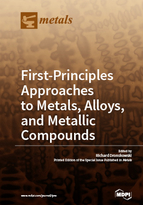First-Principles Approaches to Metals, Alloys, and Metallic Compounds
A special issue of Metals (ISSN 2075-4701).
Deadline for manuscript submissions: closed (30 April 2018) | Viewed by 56857
Special Issue Editor
Interests: quantum chemistry; solid-state chemistry; solid-state physics; crystallography
Special Issues, Collections and Topics in MDPI journals
Special Issue Information
At the beginning of the 21st century, electronic-structure theory has matured to a degree that allows for accurate phase prediction and computational characterization of various kinds of materials; in particular, elemental metals adopting whatever allotropic structure, various intermetallic compounds, and other complex metal-rich phases. Hence, fundamental theoretical progress has been made and is rapidly continuing in both physics and chemistry. From a more applied, engineering-like perspective, there is an urgent need for novel metallic structural materials, such as advanced steels, for future challenges arising in both mechanical and civil engineering as well as energy production and conversion. While it is clear that different microstructural features influence the macroscopic behavior, modern techniques for simulation and modeling of metals and intermetallic phases at the atomic scale may enormously accelerate and guide the entire development process. In particular, atomistic understanding is a key issue because it allows for the generation of (spin-dependent) structural models of crystalline phases and the calculation of enthalpies and other free energies as a function of pressure and temperature. In combination with evolutionary algorithms and advanced thermochemical and phase-field approaches, these methods provide a solid ground for a novel methodological approach to the physics, chemistry, and engineering of metals and metal-rich materials. Furthermore, fundamental insights obtained in this manner may be incorporated, either as input parameters or key assumptions, into larger scale models, whether purely theoretical or computational, rendering atomistic simulations essential for the development of multiscale approaches. Thus, this Special Issue focusing on first-principles approaches to metals, alloys, and metallic compounds tries to follow that train of thought, and it also aims at allowing for a wider perspective on metallic materials, to be studied by physicists, chemists and materials scientists, as well as engineers.
Prof. Dr. Richard Dronskowski
Guest Editor
Manuscript Submission Information
Manuscripts should be submitted online at www.mdpi.com by registering and logging in to this website. Once you are registered, click here to go to the submission form. Manuscripts can be submitted until the deadline. All submissions that pass pre-check are peer-reviewed. Accepted papers will be published continuously in the journal (as soon as accepted) and will be listed together on the special issue website. Research articles, review articles as well as short communications are invited. For planned papers, a title and short abstract (about 100 words) can be sent to the Editorial Office for announcement on this website.
Submitted manuscripts should not have been published previously, nor be under consideration for publication elsewhere (except conference proceedings papers). All manuscripts are thoroughly refereed through a single-blind peer-review process. A guide for authors and other relevant information for submission of manuscripts is available on the Instructions for Authors page. Metals is an international peer-reviewed open access monthly journal published by MDPI.
Please visit the Instructions for Authors page before submitting a manuscript. The Article Processing Charge (APC) for publication in this open access journal is 2600 CHF (Swiss Francs). Submitted papers should be well formatted and use good English. Authors may use MDPI's English editing service prior to publication or during author revisions.
Keywords
- metal compounds
- intermetallic alloys
- advanced steels
- electronic structure
- density-functional theory
- first-principles calculations
- materials simulations
- chemical bonding
- phase prediction
- free energies
- mechanical properties






